+ Open data
Open data
- Basic information
Basic information
| Entry | Database: PDB / ID: 1n0w | ||||||
|---|---|---|---|---|---|---|---|
| Title | Crystal structure of a RAD51-BRCA2 BRC repeat complex | ||||||
 Components Components |
| ||||||
 Keywords Keywords | GENE REGULATION/ANTITUMOR PROTEIN / DNA repair / homologous recombination / breast cancer susceptibility / RecA-like ATPase / protein complex / GENE REGULATION-ANTITUMOR PROTEIN COMPLEX | ||||||
| Function / homology |  Function and homology information Function and homology informationBRCA2-MAGE-D1 complex / negative regulation of mammary gland epithelial cell proliferation / presynaptic intermediate filament cytoskeleton / response to glucoside / mitotic recombination-dependent replication fork processing / establishment of protein localization to telomere / chromosome organization involved in meiotic cell cycle / DNA recombinase assembly / cellular response to camptothecin / telomere maintenance via telomere lengthening ...BRCA2-MAGE-D1 complex / negative regulation of mammary gland epithelial cell proliferation / presynaptic intermediate filament cytoskeleton / response to glucoside / mitotic recombination-dependent replication fork processing / establishment of protein localization to telomere / chromosome organization involved in meiotic cell cycle / DNA recombinase assembly / cellular response to camptothecin / telomere maintenance via telomere lengthening / double-strand break repair involved in meiotic recombination / nuclear ubiquitin ligase complex / cellular response to cisplatin / DNA strand invasion / cellular response to hydroxyurea / female gonad development / mitotic recombination / Impaired BRCA2 translocation to the nucleus / Impaired BRCA2 binding to SEM1 (DSS1) / DNA strand exchange activity / histone H4 acetyltransferase activity / replication-born double-strand break repair via sister chromatid exchange / histone H3 acetyltransferase activity / lateral element / regulation of DNA damage checkpoint / Impaired BRCA2 binding to PALB2 / male meiosis I / telomere maintenance via recombination / HDR through MMEJ (alt-NHEJ) / gamma-tubulin binding / reciprocal meiotic recombination / single-stranded DNA helicase activity / oocyte maturation / DNA repair complex / response to UV-C / Homologous DNA Pairing and Strand Exchange / Defective homologous recombination repair (HRR) due to BRCA1 loss of function / Defective HDR through Homologous Recombination Repair (HRR) due to PALB2 loss of BRCA1 binding function / Defective HDR through Homologous Recombination Repair (HRR) due to PALB2 loss of BRCA2/RAD51/RAD51C binding function / Resolution of D-loop Structures through Synthesis-Dependent Strand Annealing (SDSA) / Resolution of D-loop Structures through Holliday Junction Intermediates / inner cell mass cell proliferation / HDR through Single Strand Annealing (SSA) / regulation of double-strand break repair via homologous recombination / ATP-dependent DNA damage sensor activity / nuclear chromosome / Impaired BRCA2 binding to RAD51 / hematopoietic stem cell proliferation / Transcriptional Regulation by E2F6 / replication fork processing / centrosome duplication / Presynaptic phase of homologous DNA pairing and strand exchange / intrinsic apoptotic signaling pathway in response to DNA damage by p53 class mediator / response to X-ray / ATP-dependent activity, acting on DNA / interstrand cross-link repair / condensed chromosome / DNA polymerase binding / cellular response to ionizing radiation / positive regulation of mitotic cell cycle / secretory granule / condensed nuclear chromosome / regulation of cytokinesis / meiotic cell cycle / response to gamma radiation / double-strand break repair via homologous recombination / male germ cell nucleus / nucleotide-excision repair / DNA damage response, signal transduction by p53 class mediator / HDR through Homologous Recombination (HRR) / cellular response to gamma radiation / PML body / brain development / Meiotic recombination / response to toxic substance / cellular senescence / site of double-strand break / double-strand break repair / single-stranded DNA binding / double-stranded DNA binding / protease binding / spermatogenesis / DNA recombination / chromosome, telomeric region / mitochondrial matrix / response to xenobiotic stimulus / DNA repair / centrosome / DNA damage response / chromatin binding / regulation of DNA-templated transcription / chromatin / positive regulation of DNA-templated transcription / nucleolus / perinuclear region of cytoplasm / enzyme binding / protein-containing complex / ATP hydrolysis activity / mitochondrion / nucleoplasm Similarity search - Function | ||||||
| Biological species |  Homo sapiens (human) Homo sapiens (human) | ||||||
| Method |  X-RAY DIFFRACTION / X-RAY DIFFRACTION /  SYNCHROTRON / SYNCHROTRON /  MAD / Resolution: 1.7 Å MAD / Resolution: 1.7 Å | ||||||
 Authors Authors | Pellegrini, L. / Yu, D.S. / Lo, T. / Anand, S. / Lee, M. / Blundell, T.L. / Venkitaraman, A.R. | ||||||
 Citation Citation |  Journal: Nature / Year: 2002 Journal: Nature / Year: 2002Title: Insights into DNA recombination from the structure of a RAD51-BRCA2 complex Authors: Pellegrini, L. / Yu, D.S. / Lo, T. / Anand, S. / Lee, M. / Blundell, T.L. / Venkitaraman, A.R. | ||||||
| History |
| ||||||
| Remark 999 | SEQUENCE All chains in the entry are part of an engineered, chimeric protein construct. In the ...SEQUENCE All chains in the entry are part of an engineered, chimeric protein construct. In the construct, the amino-to-carboxyl order of the chains is: C-B-L-A. Chain C is a GSMG sequence that comes from the expression vector, B is the BRCA2 BRC repeat, L is the TGSTGSTGSTGSMG sequence linking chains B and A, and chain A is the RAD51 ATpase domain. Chain C appears as a separate entity because the two initial residues of chain B, 1517-8, are not visible in the density map. Likewise, the linker is not visible in the density map, with the exception of the first three residues:TGS. |
- Structure visualization
Structure visualization
| Structure viewer | Molecule:  Molmil Molmil Jmol/JSmol Jmol/JSmol |
|---|
- Downloads & links
Downloads & links
- Download
Download
| PDBx/mmCIF format |  1n0w.cif.gz 1n0w.cif.gz | 72.1 KB | Display |  PDBx/mmCIF format PDBx/mmCIF format |
|---|---|---|---|---|
| PDB format |  pdb1n0w.ent.gz pdb1n0w.ent.gz | 52.2 KB | Display |  PDB format PDB format |
| PDBx/mmJSON format |  1n0w.json.gz 1n0w.json.gz | Tree view |  PDBx/mmJSON format PDBx/mmJSON format | |
| Others |  Other downloads Other downloads |
-Validation report
| Summary document |  1n0w_validation.pdf.gz 1n0w_validation.pdf.gz | 462.6 KB | Display |  wwPDB validaton report wwPDB validaton report |
|---|---|---|---|---|
| Full document |  1n0w_full_validation.pdf.gz 1n0w_full_validation.pdf.gz | 464 KB | Display | |
| Data in XML |  1n0w_validation.xml.gz 1n0w_validation.xml.gz | 16.5 KB | Display | |
| Data in CIF |  1n0w_validation.cif.gz 1n0w_validation.cif.gz | 22.7 KB | Display | |
| Arichive directory |  https://data.pdbj.org/pub/pdb/validation_reports/n0/1n0w https://data.pdbj.org/pub/pdb/validation_reports/n0/1n0w ftp://data.pdbj.org/pub/pdb/validation_reports/n0/1n0w ftp://data.pdbj.org/pub/pdb/validation_reports/n0/1n0w | HTTPS FTP |
-Related structure data
| Similar structure data |
|---|
- Links
Links
- Assembly
Assembly
| Deposited unit | 
| ||||||||
|---|---|---|---|---|---|---|---|---|---|
| 1 | 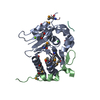
| ||||||||
| Unit cell |
| ||||||||
| Details | The asymmetric unit contains one biological unit, constituted by one chain A, one chain B and one chain C |
- Components
Components
-Protein , 1 types, 1 molecules A
| #1: Protein | Mass: 26855.346 Da / Num. of mol.: 1 / Fragment: ATPase domain Source method: isolated from a genetically manipulated source Source: (gene. exp.)  Homo sapiens (human) / Gene: RAD51 / Plasmid: pGAT3 / Species (production host): Escherichia coli / Production host: Homo sapiens (human) / Gene: RAD51 / Plasmid: pGAT3 / Species (production host): Escherichia coli / Production host:  |
|---|
-Protein/peptide , 3 types, 3 molecules BLC
| #2: Protein/peptide | Mass: 3966.598 Da / Num. of mol.: 1 / Fragment: BRC repeat type 4 Source method: isolated from a genetically manipulated source Source: (gene. exp.)  Homo sapiens (human) / Gene: BRCA2 / Plasmid: pGAT3 / Species (production host): Escherichia coli / Production host: Homo sapiens (human) / Gene: BRCA2 / Plasmid: pGAT3 / Species (production host): Escherichia coli / Production host:  |
|---|---|
| #3: Protein/peptide | Mass: 1234.091 Da / Num. of mol.: 1 Source method: isolated from a genetically manipulated source Details: this peptide links the BRCA2 to the RAD51 / Plasmid: pGAT3 / Species (production host): Escherichia coli / Production host:  |
| #4: Protein/peptide | Mass: 397.287 Da / Num. of mol.: 1 Source method: isolated from a genetically manipulated source Details: this peptide comes from the expression vector and is linked to the N-terminus of BRCA2 Plasmid: pGAT3 / Species (production host): Escherichia coli / Production host:  |
-Non-polymers , 4 types, 254 molecules 

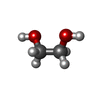




| #5: Chemical | ChemComp-MG / | ||
|---|---|---|---|
| #6: Chemical | ChemComp-CL / | ||
| #7: Chemical | ChemComp-EDO / #8: Water | ChemComp-HOH / | |
-Details
| Has protein modification | Y |
|---|
-Experimental details
-Experiment
| Experiment | Method:  X-RAY DIFFRACTION / Number of used crystals: 1 X-RAY DIFFRACTION / Number of used crystals: 1 |
|---|
- Sample preparation
Sample preparation
| Crystal | Density Matthews: 2.01 Å3/Da / Density % sol: 38.95 % / Description: Freidel pairs were used. |
|---|---|
| Crystal grow | Temperature: 291 K / Method: vapor diffusion, hanging drop / pH: 7.2 Details: ETHYLENE GLYCOL, pH 7.2, VAPOR DIFFUSION, HANGING DROP, temperature 291K |
| Crystal grow | *PLUS Temperature: 18 ℃ |
| Components of the solutions | *PLUS Conc.: 25 % / Common name: ethylene glycol |
-Data collection
| Diffraction | Mean temperature: 100 K | |||||||||
|---|---|---|---|---|---|---|---|---|---|---|
| Diffraction source | Source:  SYNCHROTRON / Site: SYNCHROTRON / Site:  ESRF ESRF  / Beamline: ID29 / Wavelength: 0.9792, 0.90831 / Beamline: ID29 / Wavelength: 0.9792, 0.90831 | |||||||||
| Detector | Type: ADSC QUANTUM 4 / Detector: CCD / Date: Apr 7, 2002 | |||||||||
| Radiation | Monochromator: channel - cut Si monochromator + cylindrical grazing incidence mirror Protocol: MAD / Monochromatic (M) / Laue (L): M / Scattering type: x-ray | |||||||||
| Radiation wavelength |
| |||||||||
| Reflection | Resolution: 1.7→24.85 Å / Num. obs: 55746 / % possible obs: 99.9 % / Observed criterion σ(F): 0 / Observed criterion σ(I): 0 / Redundancy: 7 % / Biso Wilson estimate: 16.9 Å2 / Rmerge(I) obs: 0.077 / Rsym value: 0.077 / Net I/σ(I): 23.5 | |||||||||
| Reflection shell | Resolution: 1.7→1.73 Å / Rmerge(I) obs: 0.321 / Mean I/σ(I) obs: 6.5 / Rsym value: 0.321 / % possible all: 99.9 | |||||||||
| Reflection | *PLUS Highest resolution: 1.7 Å / Num. obs: 29143 / Num. measured all: 204230 | |||||||||
| Reflection shell | *PLUS % possible obs: 99.9 % |
- Processing
Processing
| Software |
| ||||||||||||||||||||
|---|---|---|---|---|---|---|---|---|---|---|---|---|---|---|---|---|---|---|---|---|---|
| Refinement | Method to determine structure:  MAD / Resolution: 1.7→24.85 Å / Data cutoff high absF: 0 / Cross valid method: THROUGHOUT / σ(F): 0 / σ(I): 0 / Stereochemistry target values: Engh & Huber MAD / Resolution: 1.7→24.85 Å / Data cutoff high absF: 0 / Cross valid method: THROUGHOUT / σ(F): 0 / σ(I): 0 / Stereochemistry target values: Engh & HuberDetails: The structure was refined against the peak Se K edge wavelength dataset. Selenomethionine residues (residue name MSE) were used in the refinement, and are present in the deposited coordinate ...Details: The structure was refined against the peak Se K edge wavelength dataset. Selenomethionine residues (residue name MSE) were used in the refinement, and are present in the deposited coordinate file. Freidel pairs were used.
| ||||||||||||||||||||
| Displacement parameters | Biso mean: 21.1 Å2 | ||||||||||||||||||||
| Refinement step | Cycle: LAST / Resolution: 1.7→24.85 Å
| ||||||||||||||||||||
| Refine LS restraints |
| ||||||||||||||||||||
| Refinement | *PLUS Highest resolution: 1.7 Å / Lowest resolution: 24.8 Å | ||||||||||||||||||||
| Solvent computation | *PLUS | ||||||||||||||||||||
| Displacement parameters | *PLUS | ||||||||||||||||||||
| Refine LS restraints | *PLUS Type: c_angle_deg / Dev ideal: 1.229 |
 Movie
Movie Controller
Controller





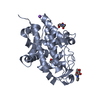


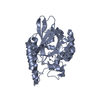

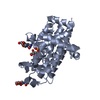
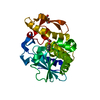
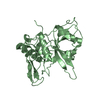
 PDBj
PDBj











